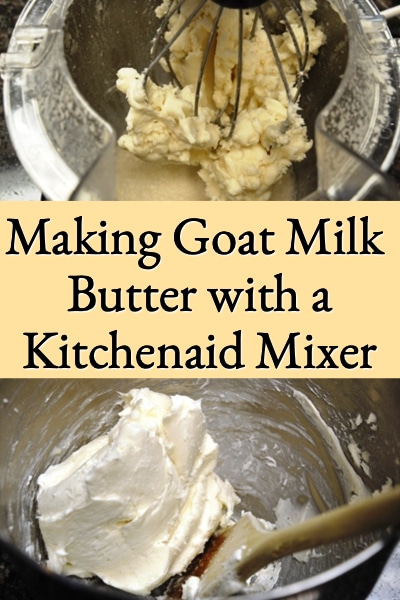
Instead, we manually separate the cream from the goat milk and use a KitchenAid mixer to churn the butter.
It takes a few days, but the cream in the goat milk does separate and rise to the top of the jars we use for storing the milk; so we just spoon the cream off and add it to a freezer container of accumulating cream.
We store the cream in the freezer (until it’s time to make the butter) to keep it fresh and prevent it from developing a “goaty” flavor.
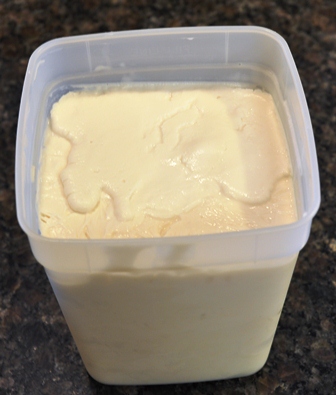
Frozen Goat Milk Cream In Freezer Container
The milk that’s left after removing the cream is still very sweet and good (it doesn’t seem watery like skim cow milk) – maybe that’s the advantage of having Nigerian Dwarf goats with their very high butterfat content milk (see 5 Reasons to Choose Nigerian Dwarf Goats for Milk).
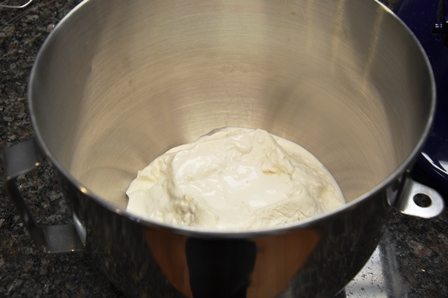
Goat Cream In Kitchenaid Mixing Bowl
How To Make Goat Milk Butter With A Kitchenaid Mixer
Step 1: Churning the Goat Milk
After we’ve accumulated about a quart of cream in the freezer, I let it thaw and put it in the mixing bowl of the KitchenAid mixer.
The churning process goes faster if you put the mixing bowl and whisk into the refrigerator for 30 minutes before adding the goat milk and churning.
Once the cream’s in the mixer, I just turn the KitchenAid up to high and let it whisk.
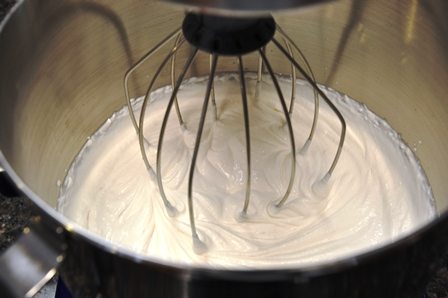
Whisking Goat Milk Cream
After whisking for a while, it will form whipped cream.
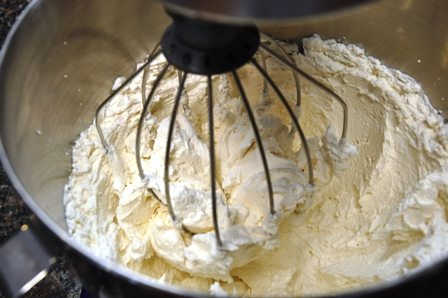
Goat Milk Whipping Cream Forming
Step 2: Adding Splatter Guards
If you have splatter guards for your mixer, it’s a good idea to put them on after whipped cream has formed. Then turn the mixer back on high-speed and keep mixing.
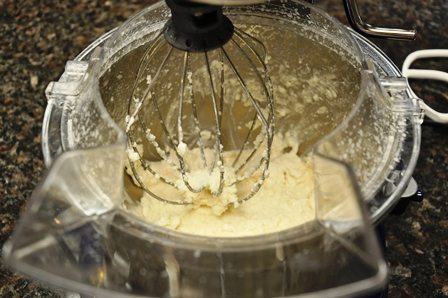
Splatter Guards Added
After mixing for a while more at high-speed, the buttermilk will start separating from the butter – and it will splatter all over.
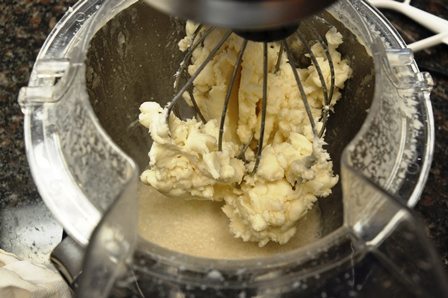
Goat Milk Butter Forming
After mixing for a while more, most of the buttermilk will have separated from the butter and the butter will cling to the wire whisk.
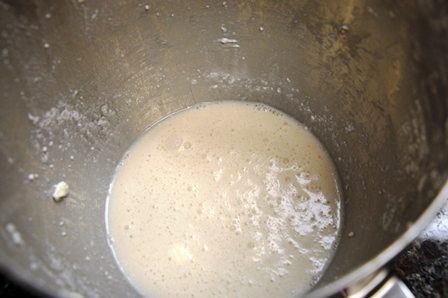
Leftover Buttermilk
The buttermilk that accumulates in the bottom of the mixing bowl is true buttermilk, not “cultured” buttermilk like you buy in the store today. We save it and use it to replace other liquids in baking – the chickens also love it.

Goat Milk Butter!
Step 3: Pour Off the Buttermilk
I pour off the buttermilk and continue to mix the butter for a bit more to see if I get any more buttermilk out – when it stops coming out then it’s butter.
I’ve read recipes that call for “washing” the butter with cold water, but we haven’t seen the need for that step yet.
Step 4: Add Coloring and Salt (if you want)
Goat milk butter is pure white, so you can add yellow food coloring and salt at this point if you want. We prefer unsalted butter and don’t mind that it’s white, so we leave it as is.
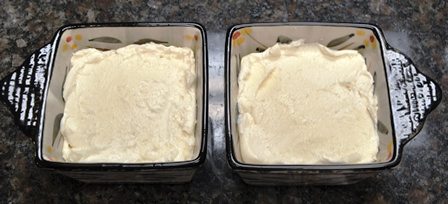
Goat Milk Butter In Ceramic “Molds”
We don’t have any butter molds yet, so I just put the finished butter in ceramic dishes and refrigerate it. It appears that we’re yielding about two cups of butter when starting with a quart of cream – and I’m thrilled to be making our own butter with equipment on hand – it’s so sweet and delicious!
Tara says
Thanks for sharing! I will be trying my hand at this. How much salt should I use if I decide to add it?
Lesa says
Hi Tara,
Well, to taste of course, but I believe about an 1/8 tsp. per cup of butter.
Ankita Jaiswal says
Lisa, all I wanted to know is that is it the same cream you gathered from boiling milk used as I can see there is malai formed after milk has cooled down. So have you used the same milk or we should use some other?
Lesa says
Hi Ankita, we don’t boil the milk – we just store the fresh goat milk in the refrigerator and after a day or two, the cream rises to the top. We skim this cream off the top and add it to our freezer container of cream and put it back in the freezer. When we have enough frozen cream accumulated, then we make butter.
Marti says
Am trying a go at goat butter. One question do I cover the goat milk in the fridge while waiting for cream? Thanks
Lesa says
Hi Marti, Yes, we store the goat’s milk in a covered container in the fridge 🙂
Essential Veda says
Thanks for sharing this amazing article…keep sharing.
Good luck
Ele says
Thanks. I had almost lost hope that I can make butter at home on my own as i failed every time. But this time following your tips to make butter, I was not only successful but found butter very delicious too. Thanks a ton!!
Lesa says
Hi Ele,
I’m so glad you’re making butter now!
Ruthie says
You have made my day with this article! I thought I was still going to have to buy butter when I got my goats!
Lesa says
Glad it was helpful Ruthie!
Ankita says
How long does the butter made from Goat milk last? Also to keep last longer can we use any kind of preservatives?
Lesa says
Hi Ankita,
Our butter lasts until we’ve used it up (we do store it in the refrigerator), and we don’t use any preservatives. We try to avoid preservatives so adding it to our butter would be counter to what we’re trying to accomplish by making fresh butter.
Jennifer says
I am milking two Nubians every morning and getting about 2 quarts of awesome milk a day. I heard the milk goes “goaty” at about day 5 so I try to use it up before that or freeze it. Desperate to try your butter method. But how old does your milk get before you can skim the cream off the top? 4-5 days? And how much can you skim off the top? Seems like it could take many weeks to accumulate enough cream.
Lesa says
Hi Jennifer,
We have Nigerian Dwarf goats, and their milk does not get “goaty” if handled properly. We have used it at much longer than 5 days and it’s still wonderful. But, they have milk that has the highest butterfat content (6 – 10%) whereas a Nubian is typically in the 4 – 5% range. I think you will have to experiment. In about 2 days, I can skim off a good bit of cream because our does are producing high butterfat content milk. It takes me a few days (4 or 5) to get enough cream to make butter.
Cary says
I got Nigerian dwarf goats a few months back. I just started milking one of the goats 2 days ago and the other doe is due to have kids any day now. I plan on making butter and cheese. Thanks to your site I now know to leave the cream in the milk when I make cheese.
Lesa says
Hi Cary, congratulations on getting Nigerian Dwarf goats! We find that the milk, cheese, and butter that we make from their milk is so good. Glad the site has been helpful 🙂
Gayle says
I also read about needing special equipment, which is why I don’t have a goat! But I do have a mixer! Yeah! But can you tell me how long does it take to run the mixer? I’m on solar power. Also, how long does it take to get a quart of cream?
Thanks!
Lesa says
Hi Gayle, I think that the time it takes to run the mixer will depend on the butterfat content of the cream you have skimmed off. Nigerian Dwarf goats have the highest butterfat content, so we find that it only takes about 10 – 15 minutes to make butter with the mixer. In fact, we laughed because we’ve unintentionally produced whipped cream (really fast) when mixing unskimmed milk that we’ve frozen. How long it takes to get a quart of cream depends on how many goats you have, but if you keep skimming and put it in the freezer, you’ll get there whether you have one or several.
Kim says
If you skim the cream off the top for butter, can you use what is left and still make cheese? Or, do you need the cream in there for the cheese? Love your site!!! We are new to the “goat loving” adventure and you have proved to be so helpful already! Thank you!!!
Lesa says
Hi Kim, I think that one of the elements that contributes to “good” cheese is butterfat, and if you skim the cream off to make butter you’re removing that element. I think that’s why Nigerian Dwarf goat milk makes such good cheese, because it’s a little higher in butterfat content than the standard breeds. So, we just drink the milk that we’ve skimmed to make butter, and use unskimmed milk to make cheese. Congrats on the goats, and thanks!
Bruce says
Nothing was mentioned about needing a culture mix with your process. Do you add anything other than what is in this article?
Lesa says
Hi Bruce, we don’t add a culture mix or anything, just skim the cream off the top and save it until we get enough to make butter.
sherri says
Hi Lesa,
I have had African Nigerian Dwarf goats for over 5 years, never has cream risen to the top like cows milk. However, I will see a nice thick chunk occasionally in the milk that would be in the amount of a tablespoon. I always understood goats milk to be naturally homogenized meaning it doesn’t separate to the top. What are you feeding your goats, maybe it is in the diet that allows the cream to separate and float to the top?
Thanks,
Sherri
Lesa says
Hi Sherri, Goat milk is naturally homogenized unlike cow milk; however with time it will separate. I don’t understand how yours is not – do you wait a few days? As far as feeding, we feed free choice alfalfa, goat mineral, and baking soda. We also feed does in milk Kalmbach milk & meat grain concentrate about 1 lb. per day depending on how much milk they are producing and their condition. We top dress the grain with BOSE and calf manna. Hope this helps.
Amber Mandler says
We just had a nanny lose her baby due to being born during the night in negative temps. So for the past week I have been milking her twice a day and getting about a pint each day. Today I tried to make butter from the cream (we got a quart) I didn’t get quite 2 cups it also didn’t get to the whipped cream phase. Did I do something wrong? I used my kitchenaid mixer.
Rebecca says
Can you make butter from goat milk that has been frozen?
Lesa says
Hi Rebecca, as long as the milk separates so you can skim off the cream, it should make butter.
Roshni says
I wanted to know if the cream you used is the same cream that can be collected after boiling milk. A heavy layer that settles on top after it boils and cools down.
Lesa says
I don’t think it’s the same as the cream that naturally separates out when the milk is cold.
Teri Mills says
Having found myself on your blog 3 times in two days after googling goat or farm related issues, I decided I should really subscribe. Thank you for such helpful tips and ideas.
Lesa says
Hi Teri, Thank you for subscribing!
Melinda Pepper says
Can’t wait to try this! I think is will be a while tho.
Lesa says
Yes, I think it will be a little while before you’ll be trying this with milk from your goats 🙂
Anne says
I am procuring some raw goat milk from friend today. She doesn’t make butter but makes cheese. I’m going to do butter. During cheese making I know you have to heat the milk with butter you do not. (I’ve never used raw milk ever at all so I’m a little hesitant) Lol. Do you heat or anything or do you just use it raw straight from the goat? I’m soooo excited . I’ve made lots of butter but never with raw milk or from a goat.
Lesa says
Hi Anne,
You can heat the milk to pasteurize it, or you can leave it “raw” to make butter. We know exactly what’s going into the milk our goats are producing and how clean everything is maintained, so we’re not afraid to use their milk without pasteurizing it. Pasteurizing the milk destroys some of the probiotic organisms, but it also destroys the bad germs that can make you sick. So, I guess it all depends on how comfortable you are with the source of your raw goat milk.
Danielle says
I was wondering about how long is, “for a while”? I’ve been on the first step letting the cream mix on high and I don’t seem to be getting anywhere. Wondering if I got to much milk and not just cream, or if I’m not waiting long enough. Thank you for your blog.
Lesa says
Hi Danielle, I think that you should be through with the first step within about 10 minutes or less. It varies, but the whipped cream usually forms pretty quickly for us.
Supermom says
I don’t have access to raw goats milk that I can trust… Pardon my ignorance, but can I substitute pastruzed goat milk from the store? We use myenberg brand. Thanks!
Lesa says
Hi Supermom,
I’ve never tried using pasteurized goat milk from the store, but as long as it separates, I wouldn’t see why it would be any different. Pasteurization is just heating it – let us know what happens 🙂
Ellen Cadwell says
We just purchased 3 Nigerian Dwarf goats, and have one goat (so far) that we can milk. I have been saving the milk in vacuum sealer bags (just sealing, no vacuum) until I have enough to try making butter. I have been told that frozen milk will still be just as good as if it wasn’t frozen. What I need to know is: 1) can I leave the bags out until they are thawed (but still cold) before putting in the fridge for days to allow the separation? 2) Can I refreeze the buttermilk liquid that is left when the butter is separated? It is just my husband and myself, and I don’t want the liquid to go to waste if I can’t use it that quickly for baking or whatever. Thanks for your blog. I’ve looked at several and your method seems it will work the best for me.
Lesa says
Hi Ellen, I think the answer to both questions is yes. We don’t find that our goat milk goes bad very quickly, but we do try to treat it gently.
Ellen Cadwell says
Thank you for answering Lesa. I’m hoping to skim the cream tomorrow. Can’t wait to try making my own butter!
Carolyn says
All pasteurization is is heating the milk to a certain temperature for a certain amount of time. Doesn’t affect taste. All it takes is one instance of someone getting sick. And Lesa, that’s not entirely true about gov regs. It was to provide healthy, safe options for everyone. Most farms in the US are still family owned and run. Several states do allow raw milk sales, check state policy if interested. Source: I’m an ag Extension agent, and raised dairy goats myself.
Robin says
Raw milk has more nutrition than pasteurized milk. Frozen Breastmilk is never pasteurized because it kills antibodies and breaks down beneficial components of the milk. I agree with Lesa, good husbandry and small family herd management is adequate in providing clean, safe milk.
Lisa says
Hi, I’m new to goats & love your instructions. I dont want to get my family sick! If i refrigerate the milk right away, can i skip pasteurizing it? Or is that a necessary step? Thanks
Lesa says
Hi Lisa, there’s lots of debate on the subject of raw milk and whether it needs to be pasteurized. If you are careful with how you handle the milk and keep everything sanitary, then many people feel that pastuerization is unnecessary. The government started require that milk be pasteurized after farms moved away from being small family farms and became large industrialized operations where the animals were kept on feedlots, sanitation was not always good, and the milk from many operations were dumped into common tanks. So yes, many people skip pastuerizing it, and feel that it is much better for you.
Nichole says
Do you put your milk in the fridge while waiting for it to separate?
Lesa says
Hi Nichole – Yes, it’s really important to cool the goat milk quickly and keep it cool while it separates.
Andreas Petrides says
I own and operate a wholesale bakery and we are trying to find goat butter to use in some of our specialty recipes. Any ideas where to look for it. We need to be buying wholesale.
Lisa says
Love this post! I was wondering if you know how long the butter is good for?
Lesa says
Hi Lisa, we keep the butter in the refrigerator, and it seems to last a long time. As in, I don’t know how long it lasts because we’ve always eaten it all before it wasn’t good.
Rebecca | LettersFromSunnybrook says
Great instructions! Oh my, I just discovered your goat stall cam below. As if my family doesn’t think I am nuts already, now they’ll be asking why I am stalking someone’s goats over my computer. Love it!! 😀
Lesa says
Hi Rebecca, glad you like the instructions and the cam – it’s really most useful during kidding season, then they can’t sneak those kids in when we’re not around 🙂